Top Qs
Timeline
Chat
Perspective
Republic of China Military Academy
Military academy of the Republic of China From Wikipedia, the free encyclopedia
Remove ads
The Republic of China Military Academy (Chinese: 中華民國陸軍軍官學校; pinyin: Zhōnghúa Mīngúo Lùjūn Jūnguān Xúexiào; Pe̍h-ōe-jī: Tiong-hôa Bîn-kok Lio̍k-kun Kun-koaⁿ Ha̍k-hāu), also known as the Chinese Military Academy (CMA), is the service academy for the Republic of China Army. It was founded as the Whampoa Military Academy at Whampoa, Canton (present day Huangpu, Guangzhou) in 1924. At the end of the Chinese Civil War the academy evacuated to the island of Taiwan and took its current name. Its graduates participated in the Northern Expedition, the Second Sino-Japanese War and the Chinese Civil War.
This article needs additional citations for verification. (May 2019) |
Remove ads
Establishment


By 1924, the Kuomintang (KMT) wanted to build a modern, and politically reliable armed force. The KMT received money, materiel, and advisors from the Soviet Union; military advisors provided training and began reorganizing the KMT's forces along Soviet lines. As part of the reforms, political commissars were introduced for political and technical training and, in 1924, the KMT's 1st National Congress approved the creation of the Whampoa Military Academy to train junior officers for the what would become the National Revolutionary Army (NRA). The academy was established in May 1924[1] on Dane's Island (present day Changzhou Island)[citation needed] in Huangpu, Guangzhou with Chiang Kai-shek as superintendent.[2] Liao Zhongkai, the KMT treasury secretary, was the party's representative to the academy. Sun Yat-sen took the ceremonial position of the academy's premier.[3]
Remove ads
Early years
Summarize
Perspective

The Chinese faculty included graduates from the Baoding Military Academy, the Yunnan Military Academy, and the Imperial Japanese Army Academy. There were also a small number of Soviet instructors trained at the Frunze Military Academy;[4] they were the academy's primary instructors.[5] Members of the Chinese Communist Party (CCP) were admitted as faculty and students as part of the First United Front.[4] The political instructors were mostly Communists, as was their director, Zhou Enlai.[6] The later People's Liberation Army also recruited Whampoa graduates.[7]
The academy's provided a 6-12 month[3] military-political program incorporating Western pedagogical methods and practical exercises. Military training was primarily infantry-focused, but also included classes for artillery, engineers, logistics, and heavy weapons. Political training was based on Sun Yat-sen's Three Principles of the People, KMT history, and Western politics and economics.[4] The program was inferior to those provided by contemporary professional armies, but it gave the NRA an advantage over the less professional Chinese armies of the Warlord Era.[3] The first class of 490 graduated in November.[2]

The academy formed the first "model" regiment in October 1924, which suppressed an insurrection of angry merchants and their private militia forces late that month. The Whampoa force operated successfully during the Guangdong–Guangxi War and the Yunnan–Guangxi War[2] before becoming the foundation of the NRA.[7]
By the start of the Second Sino-Japanese War in 1937 the majority of Chinese divisions were commanded by Whampoa graduates.[3]

Remove ads
Relocations

The original academy operated until 1926.[3] In 1928, following the Northern Expedition, it was relocated to Nanjing, the new capital, and renamed as the Central Military Academy. The CMA evacuated to Chengdu in 1938 during the Second Sino-Japanese War.[citation needed]
At the end of the Chinese Civil War, the CMA evacuated to Kaohsiung on Taiwan and was renamed to the Republic of China Military Academy.[citation needed]
The site of the Whampoa Military Academy is now a museum.[citation needed]
In Taiwan
In June 2024, President Lai Ching-te visited the ROC Military Academy on the occasion of its 100th anniversary celebration.[8]
List of superintendents
- Note: "class year" refers to the alumnus's class year, which usually is the same year they graduated. However, in times of war, classes often graduate early.
- A "—" in the class year column indicates a superintendent who is not an alumnus of the Academy.
Remove ads
Faculties
- Center for General Education
- Department of Civil Engineering
- Department of Physics
- Department of Foreign Languages
- Department of Political Science
- Department of Management Science
- Department of Chemistry
- Department of Electrical Engineering
- Department of Mechanical Engineering
- Department of Information Management[9]
Notable alumni
- Lee Shying-jow, Minister of Veterans Affairs Council (2016–2018)
- Lin Biao, Marshal of the People's Republic of China [3]
- Justin Yifu Lin, Chief Economist of the World Bank
- Ma Zhongying, Ma clique warlord[10][11][12]
Transportation
The academy is within walking distance south of Dadong Station of the Kaohsiung MRT.
See also
- List of schools in the Republic of China reopened in Taiwan
- National Chengchi University, the civil counterpart of the Whampoa Military Academy
- Republic of China Naval Academy
- Republic of China Air Force Academy
References
Further reading
External links
Wikiwand - on
Seamless Wikipedia browsing. On steroids.
Remove ads








